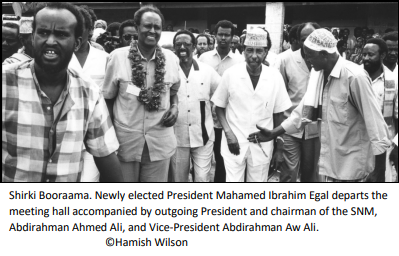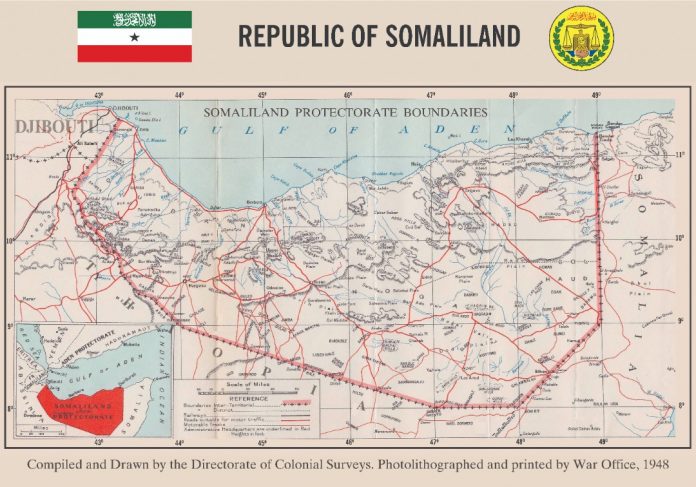The origins of the modern Republic of Somaliland and the territories of which it is comprised can be traced back to 1884 when the British government, from its base in Aden, signed treaties with elders of the Somali clans that inhabit the Somaliland region. The treaties formed the basis for the establishment of the Protectorate of Somaliland which, except for a brief period of seven months in 1940, was administered by the British government until the granting of independence in 1960. Throughout this time the international territorial boundaries of Somaliland agreed in the 1884 treaties remained unchanged.
The only incident connected to the boundaries which occurred during this period related to
the administration of land to the south of Somaliland’s border with Ethiopia. This area had
been subject to a separate Anglo–Ethiopian treaty signed in 1897 in which a large area of the Somali-inhabited Haud and the so–called “Reserved Area” was administered, but not owned, by the British as a part of their Somaliland Protectorate. Towards the end of 1954, a second agreement confirming the ownership of this land by Ethiopia was signed by Great Britain and Ethiopia. In February 1955, amidst widespread protestation by the Somali clans who inhabited the area, the British administration withdraw from the southern Haud and Reserve Areas and handed full control to the Ethiopians. Throughout this process, the boundaries of the Somaliland Protectorate remained unchanged and on 26th June 1960 it was the territory agreed in the 1884 treaty which was returned by the British government back to its Somali inhabitants.
After the granting of independence by Britain on 26th June 1960, the former Protectorate of Somaliland became known as the State of Somaliland. It held this independent status until 1st July 1960 when it united with the Trust Territory of Somalia (formerly known as Italian Somaliland) to create the Somali Republic. Despite sharing a common language and religion and there being a universal swell of nationalist feelings, the union was never successful. From the outset, inhabitants of the two territories encountered differences in attitudes to law, order, and governance, many of which stemmed from incompatibilities inherited from the respective colonial administrations. There were also cultural differences between the northern Somali clans and those from the south, including variations in attitudes towards traditional elders and religious leaders, all of which were exasperated by the geographical separation between Mogadishu and Hargaysa. Above all, the failed attempt to create a united Somali republic represented the first time in history that a sizeable portion of the Somali nation had been ruled by a single central government. Until then, the needs of a predominantly nomadic society, especially amongst those clans living in the centre and north, had not required such institutions. This avoided the possibility in which one group of Somalis could govern lives of another. The creation of the Somali Republic for the first time allowed the opportunity for a single group of Somalis, or clan, to dominate others, and the temptation to do so proved irresistible.
Ultimately it was the regime led by the dictator Mohamed Siyad Barre which oversaw the
collapse of the Somali Republic. His increasingly autocratic rule relied upon favouritism for his own sub–clan of Darood and the subjugation of other clans whom he regarded as a threat to his regime. First, he fought with the Mijertayn clan in the north–east of Somalia before embarking on a campaign to persecute and supress the Issaaq clan who are the majority inhabitants of the former British Protectorate of Somaliland. The oppression perpetrated by the regime against the Issaaq led to the formation in 1982 of the Somali National Movement, an organisation specifically created to remove the regime of Mohamed Siyad Barre and in its place instal a democratic government. In 1988, when the SNM’s struggle against the regime erupted into full–scale civil war in the north–west, the oppression of the Issaaq immediately developed into a genocide as Mohamed Siyaad Barre’s military sought to remove the Issaaq from their land and in their place install Somali clans and other groups which had fled Ethiopia following the 1977–78 Somali–Ethiopian war in the Ogaden.
The fall of the regime in Mogadishu came in January 1991 when the SNM ousted the regime’s forces from the north–west and liberated their land, whilst simultaneously two other opposition movements in the south, the United Somali Congress, and the Somali Patriotic Movement, occupied the central and southern regions of Somalia. With the fall of the regime, so too came the final disintegration of the Somali Republic. The anarchy and inter–clan conflict which immediately erupted in Mogadishu and the south following the overthrow of Mohamed Siyad Barre eventually convinced the SNM leadership that their long–held ambitions to install a democratic government for all of Somalia were impossible. At the same time, the inhabitants of the north–west, seeing the chaos in the south, and fearful of a repeat of the genocide which had been waged against them by the previous regime, began demanding independence for their region. On 18th May 1991, in the city of Burco, and after weeks of intense public debate, the inhabitants of the territory formally known as the State of Somaliland, unilaterally declared a return to the independent status they had held following the granting of independence by the British government on 26th June 1960.
regime’s forces from the north–west and liberated their land, whilst simultaneously two other opposition movements in the south, the United Somali Congress, and the Somali Patriotic Movement, occupied the central and southern regions of Somalia. With the fall of the regime, so too came the final disintegration of the Somali Republic. The anarchy and inter–clan conflict which immediately erupted in Mogadishu and the south following the overthrow of Mohamed Siyad Barre eventually convinced the SNM leadership that their long–held ambitions to install a democratic government for all of Somalia were impossible. At the same time, the inhabitants of the north–west, seeing the chaos in the south, and fearful of a repeat of the genocide which had been waged against them by the previous regime, began demanding independence for their region. On 18th May 1991, in the city of Burco, and after weeks of intense public debate, the inhabitants of the territory formally known as the State of Somaliland, unilaterally declared a return to the independent status they had held following the granting of independence by the British government on 26th June 1960.
Acting in accordance with their constitution, the SNM set up an interim administration in the newly created Republic of Somaliland and began preparations to install a democratically
elected government. To ensure consensus amongst all inhabitants of Somaliland concerning
the future of the independent republic, at the beginning of 1993, the council of elders, known as the Guurti, organised, and officiated over, a peace conference in the town of Boorama. This was attended by representatives of all clans, groups, and organisations with vested interests in Somaliland. “Shirkii Boorama”, as the gathering became known, was held against the wishes of the United Nations operations in Somalia (UNOSOM) and other international organisations who sought to return Somaliland to rule by Mogadishu. Yet the meeting became one of the most significant events in the modern history of the Somali region, paving the way for the peace, stability, and democracy which has characterised
Somaliland as an independent republic for the past thirty–two years.
Shirki Booraama concluded with the first democratic elections for the roles of President and Vice–President to be held in the Republic of Somaliland. This in turn paved the way for the creation of upper and lower houses of parliament and the beginning of a transition to the current modern multi–party system of democracy and voter registration which has been independently verified to operate at levels of accountability and transparency that rival any other country in the world.
 Shirki Booraama also called for the writing of a Constitution for Somaliland, article 2 of which concerns Somaliland’s boundaries. “The territory of the Republic of Somaliland covers the same area as that of the former Somaliland Protectorate and is located between Latitude 8’ to 11’ 30’ north of the equator and Longitude 42’ 45 to 49’ East; and consists of the land, islands, and territorial water above and below the surface, the airspace, and the continental shelf.”
Shirki Booraama also called for the writing of a Constitution for Somaliland, article 2 of which concerns Somaliland’s boundaries. “The territory of the Republic of Somaliland covers the same area as that of the former Somaliland Protectorate and is located between Latitude 8’ to 11’ 30’ north of the equator and Longitude 42’ 45 to 49’ East; and consists of the land, islands, and territorial water above and below the surface, the airspace, and the continental shelf.”
On 31st May 2001, the draft constitution, which had been in public circulation for several months, was subjected to a national referendum. 99.9% of eligible voters took part in
the referendum and 97.1% of them voted in favour of the constitution. In so doing, voters
affirmed Somaliland’s independence from Somalia and its claim to the territorial borders
described in the constitution.
For the Somali National Movement, the holding of the first democratic elections in Somaliland signalled the successful completion of the mandate set out in its constitution. In 1993, following the closure of Shirki Boorama, the SNM Central Committee convened its final meeting at which members unanimously voted to disband the movement. Since then, no organisation bearing the name, or representing former members of the SNM, has existed.
The continuous process of consultation, debate, and democratic decision making which has
underpinned the formation and governance of the Republic of Somaliland has always been
inclusive. Although the majority, but not all, of the SNM’s membership were drawn from the
Issaaq clan, even before the end of the civil war, efforts were being made to negotiate peace with other clans in the region. These included discussions with the inhabitants of Awdal, Seylac, and especially Sool. In October 1990, a delegation from Laascaanood led by Garaad Abdigani arrived at the SNM’s headquarters to discuss relations between his own
Dhulbahante clan and the Issaaq. It was concluded that the two clans, many of whom
traditionally inter-marry, shared extensive cultural and historical links, not least of which was inclusion in the British Protectorate of Somaliland. In the opinion of the Garaad, his people had been deceived by Mohamed Siyad Barre into believing that the Issaaq were their enemies when in fact they were their allies. The agreement made on this occasion and the statements released by both parties paved the way for peace between the two clans when three months later the civil war ended and a little later, the formation of the Republic of Somaliland was declared.![]()




























